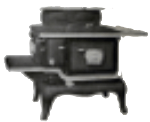Women Inventors: Changing the Stove for Themselves
As many of the improvements of the stove were made in support of making the typical roles of men easier, I was curious in the ways that women contributed to the development of kitchen ranges. Most of the people mentioned in a more generic history of the stove mention key men inventors, but there were women inventing and patenting their work which would influence the way that large companies would improve upon their designs and advertisements.
The first woman of note was Mary Evard. In 1850, she invented an improved cooking stove which divided the oven chamber into two to allow for half to be for dry baking and the other half for moist baking. This kind of idea is unique to someone who works in a kitchen, especially a domestic one where you become very familiar with your stove and what you need to be able to do with it. As industry is dominated by men it is the work of women like Mary Evard who instill the work into the machine.
Another prominent woman was Elizabeth Hawks who patented a baking attachment for stoves in 1875. Its purpose was to more evenly distribute heat in the chamber to cook things like loaved and have them develop a better, more tender crust. This “Auxiliary Air-chamber for Stoves” was immensely popular and sold thousands of units within months of its release. This design seems to have been taken into account by manufacturing companies at least in concept. One way that I believe this design lived on in stove advertisements is the appearance of the “pre-heating” process as described in stove catalogues and manuals that talk about getting an oven up to temperature to evenly distribute the heat to cook and bake food.
Both of their patents are displayed on the side of this page and in the collection gallery.
